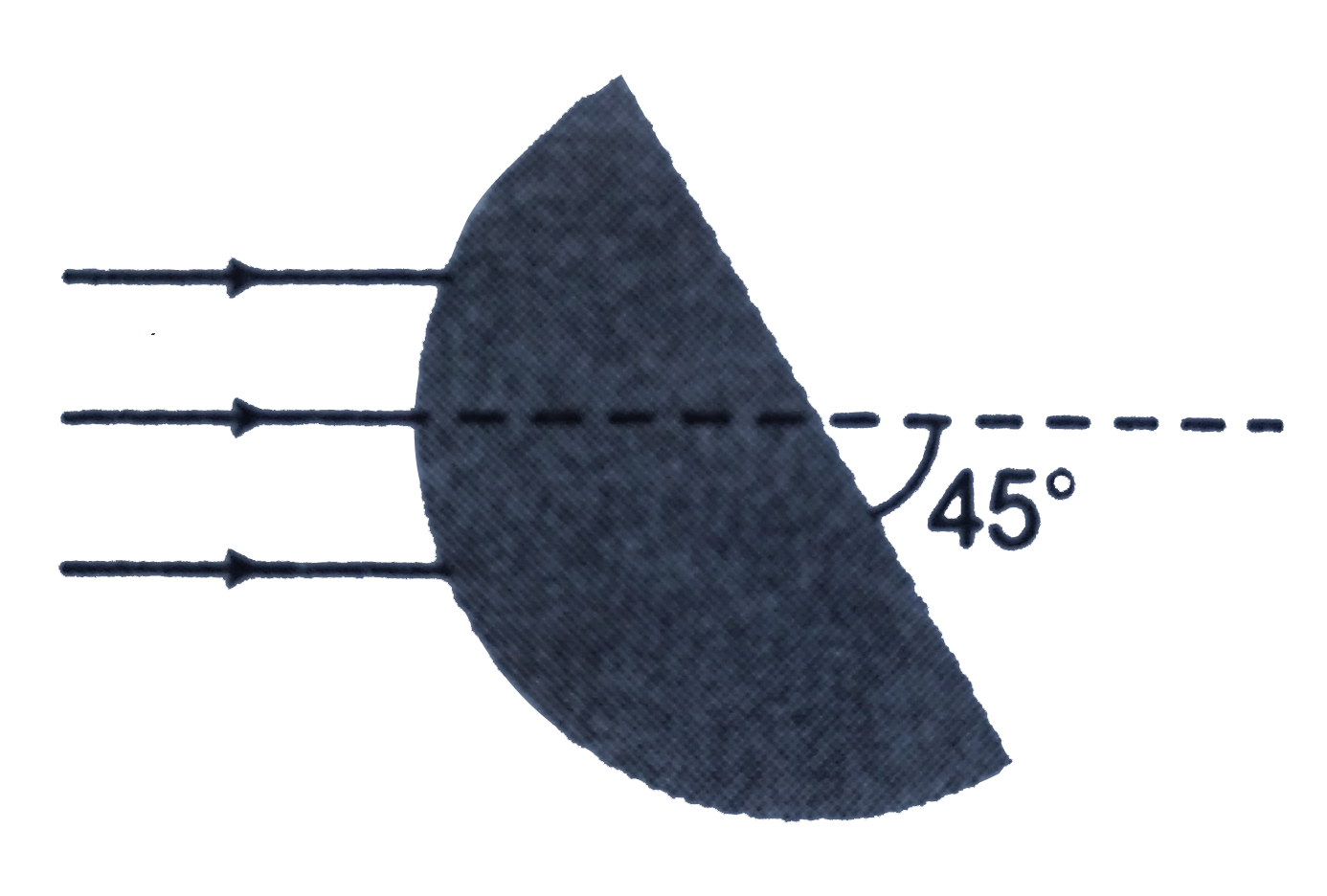A parallel bean of light travelling in water (refractie index =43) is refracted by a spherical bubble of radius 2 mm situation in water. Assuming the light rays to be paraxial. Find the position of the image due to refraction at the first surface and the position of the final imageSolution in Gujrati
 <br> The ray diagram is shown in ure. The equation for refractioin at a spherical surface is <br> <span class=) μ22−μ12=μ2−μ1R………….i
μ22−μ12=μ2−μ1R………….i
For the first refraction (water to air ) μ1=1.33,μ2=1,u=∞,R=+2 mm.
Thus, 1v=1−1.332mm
or v=-6mm<br>The¬ativesignshowstˆtheima≥I_1isvirtualandformsat6mmomthesurfaceofthebu≤onthewaters.Theretedrays(whichseem→comeomI_1)are∈cntonthefarthersurfaceofthebu≤.forthisretion.<br>mu_1=1, mu_2=1.33, R=-2mm<br>theobjectdistanceisu=-(6mm=4mm)=-10mm. Usingequationi<br>1.33/v+1/(10mm)=(1.33-1)/(-2mm)<br>or1.33/v=-0.33/(2mm)-1/(10mm)<br>v=−5mm
the minus sigh shows that the image is formed on the air side at 5 mm from the refracting surface.
Measuring from the centre of the bubble,the first image is formed at 8.0 mm from the centre and the second image is formed at 3.0 mm from the centre. Both images are formed on the side from which the incident rays are coming.
Topper's Solved these Questions
- BOOK - HC VERMACHAPTER - GEOMETRICAL OPTICSEXERCISE - Short Answer18videos
GEOMETRICAL OPTICS
- BOOK - HC VERMACHAPTER - GEOMETRICAL OPTICSEXERCISE - Question For short Answer1videos
GEOMETRICAL OPTICS
- BOOK - HC VERMACHAPTER - GEOMETRICAL OPTICSEXERCISE - EXAMPLE3videos
GEOMETRICAL OPTICS
- BOOK - HC VERMACHAPTER - GAUSS LAWEXERCISE - Exercises24videos
GAUSS LAW
- BOOK - HC VERMACHAPTER - LIGHT WAVESEXERCISE - Exercises41videos
LIGHT WAVES
Similar Questions
Is the formula "Real depth/Apparent depth =μ. valid if viewed from a position quite away from the normal ?
07:33View SolutionTwo converging lenses of unequal focal lengths can be used to reduce the aperture of a parallel beam of light without loosing the energy of the light. This increases the intensity. Describe how the converging lenses should be placed to do this.
01:46View SolutionA convex mirror has its radius of curvature k=20 cm. Find the position of the image of an object placed at a distance of 12 cm from the mirror.
 03:49View Solution
03:49View SolutionThe electric field in a region is given by →E=35E0→i+45E0→j with E0=2.0×103NC−1. Find the flux of this field through a recatngular surface of area 0.2m2 parallel to the y-z plane.
01:34View SolutionFind the range of frequency of light that is visible to an average human being (400nm<λ<700nm)
01:45View SolutionA parallel bean of light travelling in water (refractie index =43) is refracted by a spohereical bubble of radius 2 mm situation in water. Assuming the light rays to be paraxial. i. find the position of the image due to refraction at the first surface and the positoin of the final image, and ii draw a ray diagram showing the positions of oth the images.
08:02View SolutionA parallel narrow beam of light is incident on the surface of a transparent hemisphere of radius R and refractive index μ=1.5 as shown. The position of the image formed by refraction at the image formed by refraction at the spherical surface only as
 03:29View Solution
03:29View SolutionA parallel beam of light travelling in water (refractive index =4//3) is refracted by a spherical air bublle of radius 2mm situated in water. Assuming the light rays to be paraxial, a. Find the position of image due to refraction at first surface and position of the final image. b. Draw a ray diagram showing the position of both images.
02:10View SolutionA ray of light is travelling is travelling from air to water. What is the angle of incidence in air, if angle of refraction in water is 41^(@) ? Take refractive index of water = 1.32 .
05:50View SolutionA parallel beam of light is incident on the surface of a transparent hemisphere of radius R and refractive index 2.0 as shown in figure. The position of the image formed by refraction at the first surface is :
07:08View Solutionजल में चल रहा प्रकाश का एक समान्तर किरण-पुँज, जल में स्थित 4 मिमी व्यास के गोलीय वायु के बुलबुले से अपवर्तित होता है | प्रकाश- किरणों को उपाक्षीय मानकर अन्तिम प्रतिबिम्ब की स्थिति ज्ञात कीजिए | ( जल का अपवर्तनांक = 4/3 ).
04:47View Solutionवायु में स्थित किसी बिन्दुकित बिम्ब से प्रकाश 20 सेमी वक्रता त्रिज्या और 1.5 अपवर्तनांक के किसी उत्तल गोलीय लेंस पर आपतन करता है। काँच के पृष्ठ से प्रकाश स्रोत की दूरी 100 सेमी है। प्रतिबिम्ब की स्थिति ज्ञात कीजिए।
03:37View Solutionजल तथा काँच के अपवर्तनांक क्रमश: 4/3 तथा 3/2 है। जल का अपवर्तनांक ज्ञात कीजिये यदि प्रकाश की किरण काँच से जल में गमन करती है।
03:29View SolutionAn equibiconvex lens of radius of curvature 0.20 and refractive index 1.5 immersed half inside water of RI 4//3 and the rest outside in air. A parallel beam of light in air is incident on it. Find the final position of the image.
09:11View Solutionजल ( अपवर्तनांक = 4/3 ) में चल रहा प्रकाश का एक समान्तर किरण पुँज, जल में स्थित 2 मिमी त्रिज्या के गोलीय वायु के बुलबुले से अपवर्तित होता है | प्रकाश किरणों को उपाकशीय मानकर ( a ) प्रथम पृष्ठ से अपवर्तन के कारण बनने वाले प्रतिबिम्ब की स्थिति तथा अंतिम प्रतिबिम्ब की स्थिति ज्ञात कीजिए |( b ) दोनों प्रतिबिम्बों की स्थितियाँ बताने वाला किरण - आरेख खींचिए |
01:48View Solutionకాంతి గాలి నుండి నీటిలోనికి ప్రయాణిస్తున్నప్పుడు నీటి యొక్క వక్రీభవన గుణకం 1.33 అయినా కాంతి నీటినుండి గాలిలోనికి ప్రయాణిస్తున్నప్పుడు వక్రీభవన గుణకం ఎంత ?
02:43View Solution

